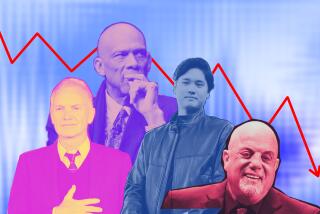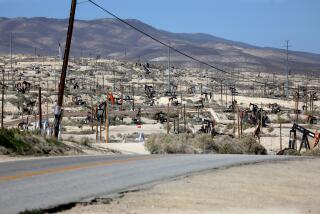Trader’s Effect Felt Powerfully in the West
In California and the Pacific Northwest, half a continent away from the Houston courtroom where former Enron Corp. chieftains Kenneth L. Lay and Jeffrey K. Skilling are scheduled to go on trial today, memories of the onetime energy giant remain vivid -- and painful.
Enron was only one of dozens of electricity wholesalers that allegedly gamed California’s haphazardly deregulated wholesale electricity market. But the go-go energy trader has emerged as a symbol of corporate greed during the state’s energy crisis of 2000 and 2001.
California utility customers, hammered by soaring bills, were shocked to hear recordings of Enron employees chuckling about how they had forced “Grandma Millie” and other helpless ratepayers to spend more to keep their lights on.
Enron’s widely copied manipulation schemes, dubbed such colorful names as “Fat Boy” and “Death Star,” pulled billions of dollars from the pockets of California ratepayers and contributed to the rolling blackouts that plagued the state during the crisis.
S. David Freeman, who ran the Los Angeles Department of Water & Power during the beginning of the energy crisis and then became an aide to Gov. Gray Davis, recalled his reaction to the role played by Enron and other energy traders.
“I said it during the crisis: ‘I don’t know if what they’re doing is legal or not, but it’s a crime,’ ” Freeman, now head of the Los Angeles Port Commission, said last week. “The impact of their conduct was so outrageous [that it goes] beyond the issue of whether it was legal or not.”
Lay and Skilling are not charged with wrongdoing in connection with the California energy crisis. They are accused of lying to Enron employees and the public as part of a conspiracy to hide the truth about the shaky financial position at their company, which filed for bankruptcy protection in December 2001. They have denied the charges.
In fact, the U.S. district judge handling the Lay-Skilling trial ruled two weeks ago that prosecutors could provide only limited testimony about Enron’s activities in California.
But three of Enron’s former top West Coast energy traders have pleaded guilty to manipulating the state’s power markets. And last July, Enron agreed to a $1.52-billion settlement of gouging accusations with California Atty. Gen. Bill Lockyer.
Lockyer, who said he expected to recover “no more than $300 million” from the Bankruptcy Court, said Californians “are still angry about the energy rip-off.”
Whether the sight of Lay and Skilling seated at the defense table in Houston does much to cool that anger is an open question.
“I think the best we can expect from the trial is some sort of psychic satisfaction that two of the ringleaders behind the fleecing that occurred in 2000 at the hands of energy marketers were brought to justice,” said Michael Shames, director of the Utility Consumers’ Action Network, a ratepayers’ advocacy group in San Diego.
Though some analysts see the Lay-Skilling trial as the beginning of the end of the Enron saga, repercussions from the energy crisis and bankruptcy continue to be felt in the Pacific Northwest.
A huge industrial sector along the Columbia River was hammered by artificially inflated electricity prices, said Robert McCullough, a Portland, Ore., energy consultant.
The Enron bankruptcy estate remains embroiled in as many as 100 active lawsuits involving public power agencies, small companies and huge corporations, McCullough said.
“There’s a huge litigation presence out here,” he said. “In our neck of the woods, it’s a long way from over.”
Gary Ackerman, director of the Western Power Trading Forum, a trade group, agrees that Enron remains a “hot button” issue on the West Coast. But he is also among those who believe that the Enron traders’ behavior, perhaps “greedy” and “immoral,” wasn’t illegal.
“The [energy trading] industry was new, and it did not have strong regulatory oversight,” Ackerman said. “That came back to haunt the folks who pushed things too far.”
*
(BEGIN TEXT OF INFOBOX)
The Enron scandal: A chronology
1985: InterNorth Inc. acquires Houston Natural Gas Corp. to form what will become Enron. Corp. Former HNG Chief Executive Kenneth L. Lay becomes CEO of the combined company that year.
1990: Lay hires Jeffrey K. Skilling to lead the company’s effort to focus on commodities trading. Andrew S. Fastow is one of Skilling’s first hires.
1997: Skilling is named president and chief operating officer. Fastow creates the Chewco partnership, the first among financial moves to hide debt and inflate profit that fuel Enron’s downfall.
1998: Fastow is named finance chief.
August 2000: Enron shares reach an all-time high of $90.
December 2000: Enron announces that Skilling will succeed Lay as CEO in February 2001. Lay will remain as chairman.
Aug. 14, 2001: Skilling resigns; Lay reassumes the CEO post.
Aug. 22: Finance executive Sherron S. Watkins meets privately with Lay to discuss concerns over murky finances and accounting.
Oct. 16: Enron announces $638 million in third-quarter losses and a $1.2-billion reduction in shareholder equity.
Oct. 19: The Securities and Exchange Commission launches an inquiry into Enron’s finances.
Oct. 23: Lay professes confidence in Fastow to analysts.
Oct. 24: Fastow is ousted.
Nov. 9: Dynegy Inc. announces an agreement to buy Enron for more than $8 billion in stock.
Nov. 19: Enron restates its third-quarter earnings and discloses that a $690-million debt is due Nov. 27.
Nov. 28: Enron stock plunges below $1 as the buyout by Dynegy falls through.
Dec. 2: Enron files for bankruptcy protection; thousands of workers are laid off.
Jan. 10, 2002: Enron’s auditor, Andersen, says it had destroyed tons of Enron documents.
Jan. 23: Lay resigns as chairman and CEO.
Jan. 25: J. Clifford Baxter, former head of Enron’s trading unit, is found dead of a self-inflicted gunshot wound.
Feb. 7: Skilling and Fastow appear before Congress. Skilling testifies; Fastow invokes 5th Amendment rights.
Feb. 12: Lay invokes the 5th Amendment at a Senate hearing after expressing “profound sadness” at Enron’s collapse.
March 14: Andersen is indicted on allegations that it destroyed Enron-related documents to thwart investigators.
June 15: Andersen is convicted.
Aug. 21: Former top Fastow aide Michael J. Kopper pleads guilty to money laundering and conspiracy. He is the first ex-Enron executive to strike a deal with prosecutors.
Oct. 17: Former top Enron trader Timothy N. Belden pleads guilty to wire fraud for participating in schemes to game California’s power markets during the state’s energy crisis in 2000 and 2001.
Oct. 31: Fastow is indicted on 78 charges including conspiracy, fraud and money laundering.
April 30, 2003: Counts against Fastow are increased to 98. His wife, Lea W. Fastow, alleged to have participated in some of her husband’s deals, is charged with tax crimes and conspiracy.
Sept. 10: Former Enron Treasurer Ben F. Glisan Jr. pleads guilty to conspiracy and is sentenced to five years in prison, becoming the first former Enron executive behind bars.
Sept. 17: Indictments are unsealed against three former Merrill Lynch & Co. bankers over their alleged roles in an Enron deal involving Nigerian power barges. A fourth Merrill ex-executive and a former Enron accountant are later charged in the same deal.
Jan. 14, 2004: Andrew Fastow pleads guilty to two counts of conspiracy and agrees to serve 10 years in prison.
Jan. 22: Former top Enron accountant Richard A. Causey pleads not guilty to conspiracy and fraud charges.
Feb. 19: Skilling pleads not guilty to more than 30 counts including conspiracy, fraud and insider trading. The indictment is expanded to increase counts against Causey to more than 30 as well.
May 6: Lea Fastow pleads guilty to a misdemeanor charge of filing a false tax form and is sentenced to the maximum sentence of one year in prison.
July 8: Lay pleads not guilty to charges of participating in a conspiracy to manipulate Enron’s quarterly financial results and making false and misleading public statements about the company’s financial performance.
July 15: Enron’s bankruptcy reorganization is approved. Most creditors will receive about one-fifth of the approximately $63 million they claim they are owed.
Nov. 3: Jurors convict four former Merrill Lynch executives and a former mid-level Enron finance executive of conspiracy and fraud in the barge case. A former Enron accountant is acquitted.
May 31, 2005: The U.S. Supreme Court overturns the Andersen conviction, ruling unanimously that vague instructions allowed jurors to convict without finding criminal intent behind the mass document destruction.
July 20: The jury in a trial involving Enron’s broadband unit acquits three of five defendants on some charges but deadlocks on most of the 164 counts.
Dec. 28: Causey pleads guilty to securities fraud and agrees to serve seven years in prison in exchange for cooperating with the government. U.S. District Judge Sim Lake reschedules the Lay-Skilling trial to today.
Source: Associated Press
Los Angeles Times
More to Read
Inside the business of entertainment
The Wide Shot brings you news, analysis and insights on everything from streaming wars to production — and what it all means for the future.
You may occasionally receive promotional content from the Los Angeles Times.











